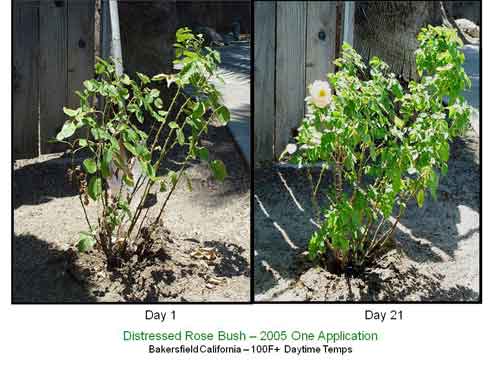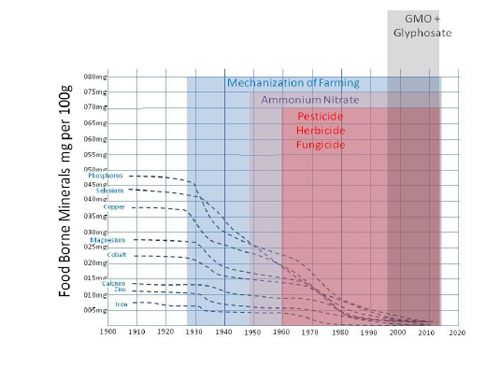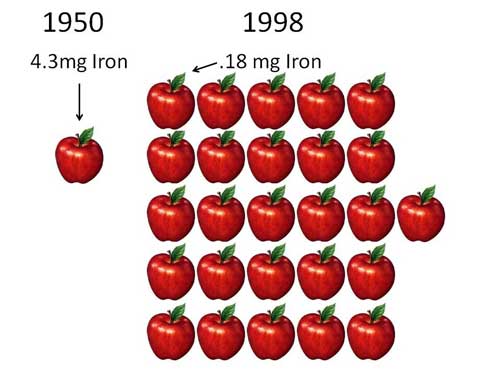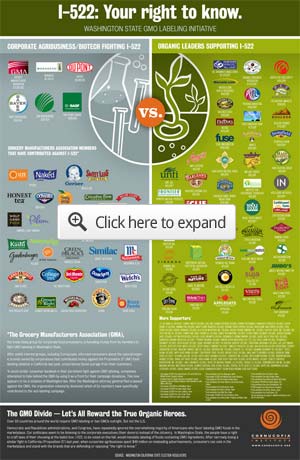How to Bring Minerals Back Into the Soil and Food Supply
Story at-a-glance
- If you eat processed foods, you’re being exposed to toxic herbicides, which mounting evidence shows are instrumental in promoting chronic disease
- The continual depletion of minerals in food matches the progressive implementation of agricultural practices like mechanization, nitrogen-heavy fertilizers, and pesticide use—all of which damage soils
- In order to receive the same amount of iron you used to get from one apple in 1950, by 1998 you had to eat 26 apples
- Ionic mineral extractions from ocean water can be used in sustainable agriculture to remineralize damaged soils, and increase the nutrition of foods grown in it
By Dr. Mercola
There are now many studies clearly documenting that if you eat processed foods, you're being exposed to toxic herbicides. These toxic chemicals have been found in everything from breast milk to umbilical cords and placentas.
This of course means that children are now born with a chemical burden unknown to previous generations. What are some of the relatively unknown consequences of this exposure?
In this interview, Dr. August Dunning, chief science officer and co-owner of Eco Organics, helps answer this important question. His company specializes in mineral products for hydroponics and home gardens. More specifically, Dr. Dunning's expertise is in ionic mineral extraction from ocean water for use in sustainable agriculture.
While contraindicated for citrus, these mineral extracts can do "miracles" for most flowering plants, fruits, and vegetables. Dunning recounts one of his earliest experiences with his partner Pam McKenzie, which led to the formation of Eco Organics:
"We tried some of these ocean minerals on some roses in the backyard of her house in Bakersfield, California. At 105-degree heat, these almost-dead roses came back in full bloom in 21 days. We saw the power of mineralization in foods and decided to put a little company together."

Eventually, his interest in organic gardening led him to evaluate glyphosate, the active ingredient in Monsanto's broad spectrum herbicide Roundup. He recently completed a five-year study on how the decrease in food-borne minerals match up with the agricultural processes used.
Glyphosate Use Has Rapidly Increased Disease Rates
Earlier in February this year, he gave a presentation at the Global Forum for Innovations in Agriculture (GFIA) in Abu Dhabi, in which he discussed the importance of minerals in food, and how the continual depletion of minerals in food matches the progressive implementation of agricultural practices like mechanization, nitrogen-heavy fertilizers, and pesticide use. As each new strategy was implemented, soil mineralization deteriorated.
"But then something really weird happened," he says. "We see this exponential increase in disease since 1988 or early '90s, which was when genetically modified (GM) food was introduced.
GM food is a patented food because it can be used with their patented herbicide, glyphosate and Roundup... That seems to have a very detrimental effect on what exists on the ground...
In commercially grown food, the mineral depletion has caused a vulnerability to the biological systems in human beings. When you start introducing these very strong chelators and endocrine disruptors, which are what glyphosate and polyethoxylated tallow amine (POEA) are, you see this huge burst in illnesses and disease rates.
I mean, it's exponentially off the chart. It's not just the mineral problems so much; it's this introduction of... in my opinion, toxic endocrine element into the food supply."
How Chemical Farming Destroys Food Quality
The following chart shows the rapidly decreasing amounts of minerals in food, initially coinciding with the introduction of mechanized farming in 1925. This began depleting minerals faster than the microorganisms in the soil could replenish the ionic minerals needed for the following year's growth, in order to maintain stable levels in the food.
In 1946, the introduction of ammonium nitrate fertilizer stimulated greater yields, but also changed the sub surface chemistry of the soil structure to lock up calcium, burn out the Humus, and cause acidic conditions to occur. This altered the subsurface decomposition chemistry to where gasses like formaldehyde and alcohol started attracting pests.
Unfortunately, instead of replenishing the mineral content to fix the pH and re-establish microorganism/mineral balance (which is the natural way to combat pests), toxic chemistry was introduced in the 1950s. These pesticides effectively killed the pests and fungi. But they also killed microorganisms, along with nature's ability to provide ionic elements needed for proper plant growth and nutrition.
As explained by Dr. Dunning, by the mid-1990s, when genetically engineered (GE) seeds and glyphosate were introduced, any minerals left were hyper-chelated and made unavailable to plants except the patented GE plants. The United States alone applies 200 million pounds of glyphosate to croplands each year. Worldwide, more than one billion pounds of glyphosate are used each year.
So, how bad is the situation, really? The sad reality is, it's quite bad. For example, Dr. Dunning's work shows that in order to receive the same amount of iron you used to get from one apple in 1950, by 1998 you had to eat 26 apples! The reason food doesn't taste as good as it used to is also related to the deterioration of mineral content. The minerals actually form the compounds that give the fruit or vegetable its flavor.
Fewer Minerals = Greater Disease Rates
As demineralization increases, disease rates rise, as indicated in the following chart. Dr. Dunning also scoured the archives of the CDC, NIH, American Heart Association, and other agencies, tracking the incidence of disease over the same periods, and came up with the second chart below. As you can see, a very clear pattern emerges when all this information is combined.
"An interesting thing just came out on the news recently about this new swine virus, where this virus is wiping out all these pigs, but not the pigs that were fed organic food, non-GMO corn," Dr. Dunning says.
"If that's the case, then it would seem logical to try and investigate the idea that the GM food, which is damaging the endocrine system that protects the animals from toxins and virus attack, is actually destroying that ability. The swine aren't dying from just the virus; they're dying from the lack of protection against viral attacks due to this GM-contaminated food."
Roundup Is Even Worse Than You Thought
Polyethoxylated tallow amine (POEA) is an adjuvant surfactant in Roundup. It's derived from animal fat, and according to the US Environmental Protection Agency (EPA) and US Department of Agriculture (USDA), it's an inert ingredient that is safe for use. However, inert does not automatically mean harmless, and this is a critical distinction to make.
"What they really aren't telling you is that it's inert in that it doesn't kill bugs, but that doesn't mean that it's not toxicologically harmful. It's inert as a bug killer, but might not be inert as a human killer," Dr. Dunning says.
POEA has actually been shown to be cytotoxic (toxic to cells) at doses far lower than glyphosate itself. It also amplifies the toxic effects of glyphosate. Dr. Dunning also notes POEA causes hemolysis—a condition where the membrane of your red blood cells burst. This removes the hemoglobin, which decreases oxygen transport in your body. If your blood isn't transporting oxygen to your brain for example, it may contribute to a wide variety of neurological problems.
"Glyphosate has several different formulations, but most of it has this additive—POEA—which is a surfactant. In other words, glyphosate tends to be hydrophilic. It doesn't want to go through the leaf surface, so they have surfactants that get dried into the leaf," Dr. Dunning explains. "Because it dries into the leaf, it doesn't wash off. It gets into the system of the plant...
POEA [also] has extremely strong detrimental effects itself. It destroys the cytochrome P450 enzyme in the liver, which is designed to detoxify toxins. When that enzyme system is damaged, these toxins are way more effective. It also destroys the ability of glutathione to be used.
Moreover, there's an interesting phenylalanine issue. Phenylalanine is needed for tyrosine, which also gets your epinephrine and norepinephrine made. If you decrease your phenylalanine [production], you don't get that cascade of chemicals. It also destroys tryptophan. Tryptophan is needed for serotonin and melatonin, so you can sleep at night. We're seeing a lot of sleep disorders in the population. Well, if you're destroying your tryptophan and your serotonin and melatonin cascade, you're going to see sleep disorders.
The World Health Organization (WHO) has studies that show that these chemicals mimic adrenaline, which is also a big part of that because norepinephrine makes your adrenaline. We're seeing these illnesses occur in humans that are very similar to endocrine-disrupting systems. We're seeing the introduction of chemicals in food that do exactly that, and no one wants to really address this issue."
How to Improve Soil Health, Naturally
Dr. Dunning has come up with a really novel biological way to address deteriorating soil health. And he's compared the results between his methods and conventional chemical-based agriculture.
In terms of food quality, his method, which involves adding naturally-occurring ocean minerals back into the soil in which the sodium has been removed, results in food with higher mineral content. This typically results in a 10-15 percent jump in the food's mineral content, compared to foods grown in untreated soils.
"We also found that when you grow organically, you get better mineral content even if you don't mineralize, because you don't have these constricting chemicals in the soil," he notes.
"What's nice about our stuff is you can mix it with water and just pour it in because it's only ionic minerals; there are no plant hormones, additives, or anything. The plant will use what it needs, because it's ionic. It only takes little, teeny, microliter sizes of the minerals to produce millions of available ions... Within a week or two, you'll see this huge greening and this growth effect."
As for application, you can use it as a soil treatment to get the roots going. The plant will develop a very large root mass, very early, which will make the plant grow very strong, very quickly. When you want to really infuse your plant with minerals, you can use it as a foliar spray.
Do You Have Earthworms?
Other important ingredients for a successful garden are carbon and earthworms. I've previously discussed the many benefits of biochar, so I won't expound on that here, other than to note its importance. Earthworms are also intrinsic allies.
"They're top tiller of the soil, you know," Dr. Dunning says. "By the time it gets out of the rear end of the worm, those minerals are ionic. The reason worm castings work is they're ionic minerals. In the carbon sink, it is great. The biochar is fantastic... You need carbon because cellulose is sugar. Plants are cellulosic materials. You need the carbon to make the sugars. You need the carbon sink and all those materials to lock the minerals, because these are anions and cations.
They're positive and negatively charged ions. When they go in the soil, they're going to grab onto something of its opposite force and dwell there... Microorganisms are producing the electrolytes, which then chelate out these ionic elements to make it available for the roots in the soil. It's a beautiful, beautiful system going on in the soil, [and] the worms are the key here. If you've got good worms, generally speaking you've got good soil."
Compost tea is another phenomenal way to increase the soil's worth. But compost tea without the right soil structure will not work all that well, because there's not enough to support the life. If the microbes don't have a "home" where they can thrive and multiply, they will soon die. Biochar, as it turns out, is an ideal home base for microorganisms, which helps explain some of its benefits to plant growth.
More Information
The conclusion I've reached after being trained as a physician and then transitioning into focusing primarily on natural health, is that once you really apply the disciplines of health and seek to take it to the highest levels, the inevitable conclusion is that you've got to get back to having a direct connection to the soil. It's essential to understand the relationship between the soil in which your food is grown, and your health.
In the end, you cannot optimize your health without good food. It's just impossible. And this is why learning what we need to do to reverse the massive destruction of our global crop soils is absolutely imperative—both on a personal and global scale. To learn more about Dr. Dunning's ionic mineral products—which include two lines: EcoVie and My Grow Minerals—please see www.EcoOrganics.com. Acres USA is another great resource where you can find a lot of information about the minerals needed for optimal soil health.
Vote with Your Pocketbook, Every Day
Remember, the food companies on the left of this graphic spent tens of millions of dollars in the last two labeling campaigns—in California and Washington State—to prevent you from knowing what's in your food. You can even the score by switching to the brands on the right; all of whom stood behind the I-522 Right to Know campaign. Voting with your pocketbook, at every meal, matters. It makes a huge difference.
As always, I encourage you to continue educating yourself about genetically engineered foods, and to share what you've learned with family and friends. Remember, unless a food is certified organic, you can assume it contains GMO ingredients if it contains sugar from sugar beet, soy, or corn, or any of their derivatives.
If you buy processed food, opt for products bearing the USDA 100% Organic label, as organics do not permit GMOs. You can also print out and use the Non-GMO Shopping Guide, created by the Institute for Responsible Technology. Share it with your friends and family, and post it to your social networks. Alternatively, download their free iPhone application, available in the iTunes store. You can find it by searching for ShopNoGMO in the applications. For more in-depth information, I highly recommend reading the following two books, authored by Jeffrey Smith, the executive director of the Institute for Responsible Technology:
- Seeds of Deception: Exposing Industry and Government Lies about the Safety of the Genetically Engineered Foods You're Eating
- Genetic Roulette: The Documented Health Risks of Genetically Engineered Foods.
For timely updates, join the Non-GMO Project on Facebook, or follow them on Twitter. Please, do your homework. Together, we have the power to stop the chemical technology industry from destroying our food supply, the future of our children, and the earth as a whole. All we need is about five percent of American shoppers to simply stop buying genetically engineered foods, and the food industry would have to reconsider their source of ingredients—regardless of whether the products bear an actual GMO label or not.
Copyright 1997- 2014 Dr. Joseph Mercola. All Rights Reserved.
http://articles.mercola.com/sites/articles/archive/2099/12/31/food-minerals-soil-health.aspx




